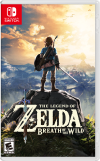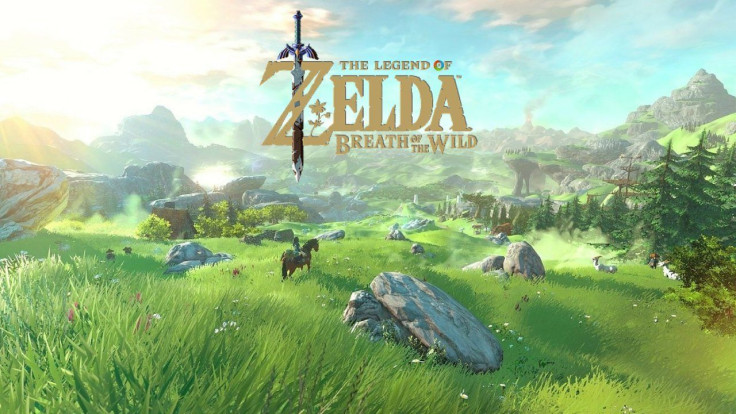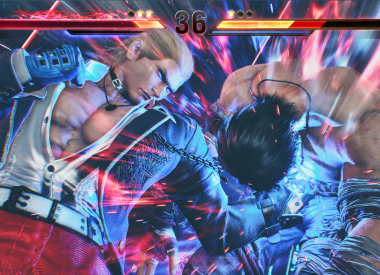There’s a lot to do in The Legend of Zelda: Breath of the Wild. From the huge map to the different weapon and enemy types, there’s a lot of information players need to know to survive in Hyrule. And since Nintendo has changed the Zelda formula up to make Breath of the Wild an ultimate test of survival, you’ll definitely need some tips and tricks to get as far into the game as you can.
How big is the map? How does food work? How does the environment impact my gameplay? All of those questions, and more, are answered in this beginner’s guide.
BASICS
Breath of the Wild is an open-world survival game, first and foremost, so there will be a lot of walking and interacting with people and the environment.
The control scheme for Breath of the Wild is pretty simple. You have an attack button that lets Link swing melee weapons and a sprint button that lets you run instead of walk. The X button lets Link climb trees and rock formations but it also lets Link jump and climb walls faster or swim faster while he’s in the water.
Running and the X button commands are tied to Link’s Stamina Wheel. This will show up on the screen as a green wheel and depletes the longer you hold onto it.
Players should be mindful of their Stamina Wheel -- it’s a great way to run away from enemies and get to destinations much faster. But beware, if the Stamina Wheel hits empty, Link won’t be able to run or use X commands until it fills all the way back up. This could leave Link open to attacks. More importantly, if Link is climbing a tall rock formation or swimming in deep water and his Stamina runs out, he will fall or drown, causing the Heart Meter to decrease.
Elixirs and food can replenish Stamina easily and that will be covered in the food/crafting section. The Stamina Wheel can be increased to allow Link to perform certain actions longer, but you’ll need certain items to do so. That part will be covered in the Shrine/Tower section.
WEATHER/ENVIRONMENT
The weather and environment play a huge role in how you play Breath of the Wild . While enemies are the most common threats Link will face during the game, players will need to be aware of the temperature and environment.
Wind speed can affect the trajectory of arrows and how fast you travel using a paraglider. Rain will make it harder to climb rock formations, but if it’s heavy enough, it can mask the noise you make while crouching helping Link become stealthier. Lightning will strike Link during a thunderstorm if he’s holding metal items and extreme cold and heat will deplete hearts gradually.
On the game screen, there is a thermometer that shows the current temperature of the area you’re in. If it reaches the blue or red bar then the temps are extreme enough to harm Link. The graph underneath the thermometer is the weather forecast that tells players what to expect in the next few minutes. You can see cloudy/wind, sunny and even if it’s going to be cold raining or a lighting storm is coming. Always keep an eye on both meters while you’re traveling.
There’s also a day/night cycle in Breath of the Wild . At night, there are more enemies lurking around, so keep that in mind before heading out of a safe village. Also, nighttime is often when temperatures become the most extreme. However, certain materials only appear at night, so weigh your options when you venture out after dark.
SHEIKAH SLATE
Link’s Sheikah Slate is an all-purpose item that you’ll be using a lot. First of all, it acts as your map in Breath of the Wild . By pressing the Minus button, you will open the world map to see where you are and everything around you. Players can also stamp points on the map to make it easier to navigate. Press the Plus button and you’ll open your inventory, where you can manage your weapons and materials. This is also where you can access the system settings and save/load if need be.
The Sheikah Slate will also tell you all the quests that you have completed or are currently in progress. These are divided into three categories: Main Story, Shrine and Side Quests.
Once you get further into the story, you’ll also gain access to Runes in your Sheikah Slate that will give Link access to bombs and other weapons that will help you on your journey, especially in puzzles.
SHRINES/TOWERS
Towers and Shrines are important to traveling in Breath of the Wild . The world map is so huge, it’s almost impossible to traverse across the land in a short amount of time. That’s where Towers and Shrines come in.
Once you’ve interacted with either, you’ll open a teleport pad that allows Link to fast travel to every Shrine and Tower he’s come into contact with. Players will want to find and activate as many as possible to make it easier to travel across Hyrule, because you’ll definitely be doing so often.
Your Sheikah Slate gains a Shrine Radar during the story, which beeps when you are close to an unactivated Shrine. The signal will grow stronger if you’re facing the right direction, so it’s a great way to find them while you're traveling.
Shrines are small dungeons that have puzzles that need to be solved to get to the end of it. Players can also find rare material and weapons if they look hard enough.
Once the puzzle is complete and the shrine is found at the end, Link will be gifted a Spirit Orb. Once you collect four orbs, you can visit specific monuments scattered across Hyrule to either increase your Heart Meter or Stamina Wheel.
We recommend increasing the Stamina Wheel, especially in the early parts of the game, so you can climb and swim longer. Extra Hearts can be found in other ways, and eating different foods refills your hearts more easily.
As for Towers, they are the tallest buildings in Hyrule, so they aren’t that hard to spot. The easiest way to find them is to go on the top of one tower and click the right analog stick to zoom in with your Sheikah Slate. This will give you a great look at the surrounding area, and you can spot Towers more quickly. What’s even handier is if you press A while in this zoomed-in mode, you can stamp the Tower so it shows on your map radar, making it easier for you to find.
Be careful while approaching Towers, as many of them are protected by hordes of enemies or some other obstacle. Once activated, Towers will give Link the layout of that area on his Sheikah Slate, allowing you to see the names of the different parts of that area as well as the topography.
WEAPONS/BATTLE
In Breath of the Wild , weapons are easy to come by, but don’t last very long. Each weapon has varying degrees of durability. Common items like Tree Branches and Hoes won’t last long in battle, but if you can find some Bokoblin Clubs or various swords they will. The same goes for Shields and Bows. The more you use them, the lower their durability becomes.
Each weapon and shield has a number on the right corner that determines your attack or defense. The description of the weapon tells you how durable it is, so keep that in mind before using.
A message will appear in battle if your weapon is close to being destroyed. Once that pops up, you can hold the R button to throw it at your enemy for even more damage.
In battle, you can press the L button to lock onto your enemy to make it easier to attack. If you have a shield equipped Link will shield himself.
There is a lot to discuss regarding weapons and battles in Breath of the Wild, so check out our battle guide for more advanced tips.
CRAFTING/FOOD
Now that hearts can’t be found in grass or pots anymore, players will have to master crafting and cooking food/elixirs to help Link stay alive in Breath of the Wild .
The basics of cooking food and elixirs goes as such: First, you’ll need to find an pot over an open flame to cook. Second, you’ll have to go into your inventory, select a material and select Hold. Link can hold up to five items at once. The more items you use, the more hearts/stamina will be restored and the longer battle effects last.
Once you’ve selected your materials, walk up to the pot and wait for the COOK command to appear. Press A and Link will mix the ingredients together.
Food restores hearts and can also give other effects, like faster movement or resistance to certain types of elements. Elixirs normally restore stamina and can also give some of the same effects as food.
Descriptions under each material will inform you what ingredients to combine, but one handy rule of thumb for cooking is that you can’t cook stone or inanimate objects. Meat, vegetables and fruit can be mixed together to make food. Monster parts, insects and plants will help make elixirs. Experiment with different combinations to figure out the food/elixirs that work best for your playstyle.
So that’s our Breath of the Wild beginner’s guide, if there’s anything you left out or want to learn more about, let us know in the comments section below.
Can’t get enough Breath of the Wild ? Check out more of our articles and guides about the game.
- Review: Expansive World, Epic Story Makes This A Must-Own
- Battle Guide: Tips On How To Take Down Your Enemies
- Horse Guide: How To Tame And Ride Horses And Other Animals
- Breath Of The Wild Amiibo: Here's Every Function For Every Figure
- Six Gifts For 'Zelda' Fans Under $25
- Beginner Item Guide: Here's The Stuff You Shouldn't Sell
- Master Sword: Where To Find Link’s Greatest Weapon
- Heart Containers Guide: How And Where To Upgrade Your Health And Stamina
- Memory Map: All Locations For Link's Lost Memories
- Great Fairy Locations: Armor Upgrades And Where To Find Them



















